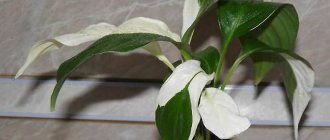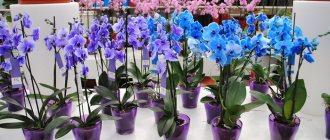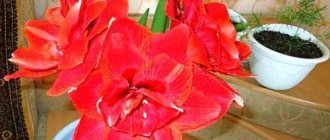This exotic beauty orchid is so attractive and unusual! Happy gardeners bring home this little joy, admire the delicate cluster of buds, and when the plant has bloomed and goes into dormancy mode, they wait again with bated breath...
If phalaenopsis does not bloom, what should I do? Your green pet needs special conditions to re-grow the flower stalk and bloom with delicate petals.
Bloom
Reasons for absence
The most precise formulation of the problem is inappropriate conditions. Flowering is a sign of plant health.
After the purchase
It takes time to get used to new conditions after purchase. A change in habitat is in itself a big test for a plant.
In nature, a flower stays in one place all its life, in a familiar environment. When the temperature regime, lighting angle, and substrate temperature change sharply, the plant has to rebuild the functioning of its tissues.
Transportation of a plant always leads to microtraumas of leaves and aerial roots, even very carefully. Also, during the “travel” there is often additional stress in the form of temperature changes.
The green pet needs to be created with optimal living conditions, close to natural ones , and given time to heal damage and adapt in general.
It is impossible to say exactly how long it will take. You can focus on a period of 12 months. If flower stalks still do not appear, it’s time to take action.
If the plant does not develop at all
If the plant has stopped developing as a whole, does not grow new leaves and, especially, does not bloom, you should start with general care and check the conditions of the plant. If properly cared for, stimulation of flowering is not necessary at all.
Substrate
tree bark is used as a substrate , then such material should not be fresh . It should also not contain fresh sawdust. Substances made from such materials are harmful to orchids.
Tree bark as a substrate.
In winter, the plant may stop growing and blooming due to living on a cold windowsill. If there is no other place for placement, you need to organize at least a stand.
IMPORTANT! In summer, the intensity of solar radiation goes off scale and can even cause burns on delicate leaves. Indeed, in its native tropics, the phalaenopsis orchid grows in the dense undergrowth of the jungle, where there is no direct sunlight. To avoid such unpleasant consequences, it is worth protecting the plant with blinds or any available method.
Lighting
In winter, when daylight hours are short and dim, the orchid may “starve” because there is not enough sunlight for the full process of photosynthesis.
During this difficult period, the tropical plant needs additional lighting.
This is easy to organize with the help of specialized phytolamps. These lighting devices emit a spectrum of light waves that are most favorable for the process of photosynthesis.
IMPORTANT! In summer, the intensity of solar radiation goes off scale and can even cause burns on delicate leaves. Indeed, in its native tropics, the phalaenopsis orchid grows in the dense undergrowth of the jungle, where there is no direct sunlight. To avoid such unpleasant consequences, it is worth protecting the plant with blinds or any available method.
Watering
Excessively abundant watering will not bring any benefit, as will extremely infrequent watering. When there is too much water, it can stagnate in the pot and rot can form on the roots. In this case, the exhausted plant has no chance of flowering.
Insufficient watering is not so harmful , it can even imitate the dry season in the tropics, but still should not be overused.
Determining the frequency of watering.
Top dressing
When phalaenopsis just begins to produce new leaves, this is an excellent moment for feeding. Flower buds, from which flower stalks will subsequently appear, are laid simultaneously with new leaves.
If such a moment is missed, and in addition the watering was incorrect, weak buds will be formed that have nothing to please.
Diseases and pests
Keeping an orchid in a residential area carries the risk of contracting diseases or pests.
If the phalaenopsis has not bloomed for 2 years or longer, it is quite possible that it is simply trying to survive under the onslaught of spider mites , which suck out all the juices.
It is useless to try to force phalaenopsis to bloom in such a situation; cure it first.
External signs of readiness
You should not be tied to the time of year to determine when phalaenopsis will bloom. This tropical miracle can bloom all year round; it comes from warm regions where winter does not occur. You just have to organize suitable conditions for him.
The age of the phalaenopsis from the moment when the baby was placed in a separate container must be at least two years. The plant should gain strength and produce four to six large leaves and a large, strong root mass.
Healthy leaves
The plant is full of health. The color of the green mass is fresh and rich. The leaves are shiny, with pronounced turgor.
Strong healthy leaves.
Roots
The roots are normally green and clean, without dark spots . Lots of aerial roots. A clear, clean pot free of green algae.
Why doesn't the orchid bloom?
Often, it is inappropriate care of the orchid that causes many problems. Inexperienced flower growers are sure that the main thing is to correctly deliver the plant from the store to the apartment, and the rest will take care of itself. This approach can lead to the rapid death of the flower.
Conditions for an orchid
To understand all the intricacies of caring for a plant, it will be useful to learn more about its life in its natural habitat. The orchid is a resident of tropical latitudes, where it is always humid and hot. In a domestic environment, the most suitable for it would be the south or side of the room. In the tropics, the orchid is reliably protected by the crowns of tall trees, but in the room there is no such protection
Therefore, it is important to create shade for the plant, because direct sunlight can burn the delicate leaves and the orchid will get sick.
There are also cold-loving varieties of orchids. Their advantage is that they are much less demanding in placement, so you can experiment with them without worrying about the consequences. However, you need to choose one specific place; you cannot move the orchid to different corners of the apartment every day, because this will definitely affect its flowering.
Additional lighting for orchids
Prolonged exposure to direct sunlight is detrimental to the flower, but it still loves good lighting. In autumn and winter, the plant does not have enough light. Therefore, it is necessary to take care of the condition of the flower during this period by installing additional lighting. To do this, you can use any type of lamp, except for an incandescent lamp, which will only heat the orchid.
You should not place it too close to the light source - this will definitely not promote flowering and may even destroy the plant. If it is not possible to provide the flower with more light, it is better to choose less demanding varieties of orchids that do well in apartment conditions.
Temperature for an orchid
Unfavorable temperature conditions are one of the common reasons that an orchid does not bloom.
When purchasing, you should pay attention to the temperature recommendations for a particular type of plant. For some of them, +20 ºC is enough, others feel good at 35 ºC, while others are comfortable at 10 ºC
When choosing, you need to take into account that the temperature in the apartment varies day and night, it also changes depending on the season
In addition, in winter it is important to ensure that the orchid does not stand close to the heating device, this can harm it
Watering orchids at home
If the orchid is watered too much, you can forget about flowering. The greatest threat is posed by liquid stagnating in the roots; it leads to plant disease and other troubles. For an orchid, as for many plants, the rule “it is better to underwater than overwater” works.
Not only the temperature in the room is important, but also the temperature of the water used to moisten the soil; if possible, it should be the same. Heat-loving plants can be watered with fairly hot water - about 38 ºC. However, even cold-loving species should not be irrigated with ice water.
There are several more rules, failure to comply with which will easily destroy the flower:
- After watering, it is best to leave the orchid and allow excess liquid to drain from the roots. If it is located in the substrate, it is advisable to select a container that is the same around the perimeter.
- The substrate should never be dry.
- In the autumn-winter period, it is best to reduce watering. It is advisable to make it more abundant in the spring, when the cold weather ends. In late spring and summer, especially in hot weather, it is worth finding a cooler place for the flower, which provides shade, this will help the orchid bloom faster.
- During flowering, it takes longer to water the plant; abundant watering during this period is simply necessary.
Feeding orchids at home
There are many types of nutrition, including nutrients and various minerals. Flower shops offer a wide range of fertilizers specifically for orchids. But you can prepare fertilizer at home. The frequency and concentration of feeding varies depending on the type of flower, as well as the stage of plant development, because it needs to be fed only during periods of active growth. You can also spray the leaves of the plant with fertilizer.
How to make a phalaenopsis orchid bloom at home?
Let's talk about how to stimulate flowering using various methods.
Primary
Do not change location during budding period
Changes in lighting have a negative effect on the orchid. The plant has to rebuild the cellular structure of tissues, adapt previously poorly illuminated parts to intensive photosynthesis.
The resources necessary for flowering remain scarce, and flowering will be delayed until better times.
If you constantly twist and rearrange the pot, you may not wait for this joyful event. Special attention should be paid to seasonal changes in natural light.
Transparent pot
Orchids are unique plants that have aerial roots. These shoots have the ability to absorb moisture directly from the air, despite their thick, gangly appearance.
The main distinctive ability of such roots is that they participate in photosynthesis in the same way as leaves, and it’s not for nothing that they are the same color.
Of course, stores now offer such an assortment of flower pots in all the colors of the rainbow that it’s a shame to plant an orchid in an unremarkable transparent container . But that’s exactly what she needs!
The best pot for phalaenopsis is transparent.
Attention! If plants of other families receive nutrients only from the leaves, then this unique plant among flowers produces chlorophyll literally with its entire body. An opaque pot will immediately deprive the orchid of half its nutrients.
Additional lighting in autumn-winter period
In winter overcooling should be avoided , so a cold windowsill is not the best place for a delicate plant. A stand is needed so that there is an air gap between the cold surface and the roots of the plant.
For optimal lighting, it is rational to use economical LED phytolamps, which will provide plant cells with light of the red and blue spectrum. This is the light that is best suited for photosynthesis.
Day and night temperature difference (as in nature)
In tropical forest conditions, the difference between day and night temperatures is about 5 degrees Celsius . It is precisely this difference that can provoke the beginning of the growth of peduncles in phalaenopsis.
Repeatedly
The use of chemicals for stimulation
succinic acid
Succinic acid gently revitalizes the entire plant and is safe even in case of overdose:
- Prepare a solution based on 500 ml. clean water and 1 tablet of succinic acid (or the amount on the tip of a knife, if in powder);
- Spray the plant completely and water with the rest.
After treatment, the phalaenopsis will begin to produce new leaves and roots, take root and begin to bloom.
Succinic acid heals phalaenopsis.
Epin
This remedy helps the plant cope with stress and adapt to new conditions.
The leaves are sprayed with this preparation, but not watered.
Stimulating dormant kidneys with cytokinin paste
A powerful method of influencing dormant kidneys. The essence lies in the action of the phytohormone cytokinin, which helps not only to awaken the bud, but also to grow from it a healthy, strong peduncle with many buds.
Cold and hot shower
A contrast shower imitates tropical rains and also removes impurities from the surface of the plant. If there are spider mites on the leaves, the flow of water will wash them away.
A contrast shower will help stimulate flowering.
Carefully! If the water temperature is above 35 degrees Celsius, you can burn the plant. In general, this is a fairly harmless method for a healthy plant, but during the budding phase it can cause significant harm, because even turning the pot is not recommended.
Orchid without roots
How to revive an orchid at home when all its roots have rotted:
- Use regular drying and dosed watering;
- Using mini-greenhouses.
After all rotten roots are removed, the orchid is treated with any root growth stimulator.
Additional Information. “Kornevin” for orchids is a root growth stimulator and is often used to solve the problem. This is a hormonal biological preparation that stimulates root formation.
Pour water into a regular glass, adding sugar or honey (1 teaspoon per 1 liter). Then the rosette of the plant is placed in the glass so that the leaves do not come into contact with the water, and the lower part is completely immersed in it. After 8 hours, the water must be drained and the flower dried. Afterwards, be sure to treat the rosette with a root growth stimulator.
A mini-greenhouse is the most effective way to resuscitate a plant in the absence of a root. Take a small container where the flower will be rooted, filling the bottom with expanded clay and the top with sphagnum. Place the rosette on the prepared substrate and place the container in the greenhouse.
Phalaenopsis leaf without roots
Be sure to comply with the following conditions:
- Temperature – 22-28 degrees,
- Lighting – up to 14 hours a day,
- Humidity – at least 70%.
The greenhouse must be ventilated and the soil moistened. After a couple of weeks, roots will begin to grow. After they reach 4-5 cm, you can plant the plant in the substrate.
No flowering
After transplant
Root system disorders
During transplantation, the plant experiences short-term but very painful stress. Cut off diseased roots should be sprinkled with crushed activated carbon to avoid the appearance of rot.
Until the plant grows its usual root mass, it will not have the strength to flower.
The soil does not support the flower
Perhaps the substrate is overly compacted and disrupts the movement of nutrients in the roots. The opposite situation, when the plant is “dangling” in a pot , also does not bode well.
After bringing the substrate to the normal fullness of the pot, the phalaenopsis will gain the required mass of roots and will be able to bloom.
Correct position of roots in the pot.
After trimming
The main problem after pruning is that there are no leaves and no flower buds in the axils. They need to be re-grown. A small amount of green mass is associated with a lack of nutrients.
It is necessary to treat with succinic acid or epin , and when the plant begins to grow, continue feeding with complex fertilizer for orchids. When the number of leaves reaches five or six, flower stalks may appear.
How to care for an orchid during flowering
Directly during flowering, it is also important to provide the orchid with quality care, which will help increase the number of buds and make them larger and brighter (Figure 5).
Note: After the first buds form, watering must be doubled, since the plant needs enough moisture to open the buds.
It is important not only to moisten the substrate, but also to spray the leaves. It is also necessary to double the intensity of feeding, since the orchid needs a large amount of nutrients to form large buds.
Sometimes it happens that an orchid throws out not one, but several flower stalks, and they are covered with numerous buds. Under their weight, the flower stalks begin to bend and break. To prevent this from happening, flower stalks are tied to special supports, which can be bought at flower shops. Also suitable for this purpose is an ordinary wooden stick, which is carefully inserted into the substrate.
Figure 5. During flowering, watering and fertilizers become more intense











